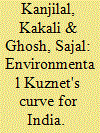| Srl | Item |
| 1 |
ID:
088958


|
|
|
|
|
| Publication |
2009.
|
| Summary/Abstract |
This study probes nexus between electricity supply, employment and real GDP for India within a multivariate framework using autoregressive distributed lag (ARDL) bounds testing approach of cointegration. Long-run equilibrium relationship has been established among these variables for the time span 1970-71 to 2005-06. The study further establishes long- and short-run Granger causality running from real GDP and electricity supply to employment without any feedback effect. Thus, growth in real GDP and electricity supply are responsible for the high level of employment in India. The absence of causality running from electricity supply to real GDP implies that electricity demand and supply side measures can be adopted to reduce the wastage of electricity, which would not affect future economic growth of India.
|
|
|
|
|
|
|
|
|
|
|
|
|
|
|
|
| 2 |
ID:
121306


|
|
|
|
|
| Publication |
2013.
|
| Summary/Abstract |
This study revisits the cointegrating relationship between carbon emission, energy use, economic activity and trade openness for India using threshold cointegration tests with a view to testing the environmental Kuznet's curve hypothesis in the presence of possible regime shift in long run relationship of the variables for the period 1971 to 2008. The article confirms the existence of 'regime-shift' or 'threshold' cointegration among the variables and environmental Kuznet's curve for India. It challenges previous empirical works for India which fail to establish cointegrating relationship among these variables and explains its logical and econometric reasons. The study finds that the carbon emission is highly elastic with respect to real per capita income and energy use in India. This finding is critical and warns successful design and execution of energy and environmental policy framework which would pave the low carbon sustainable growth path inIndia.
|
|
|
|
|
|
|
|
|
|
|
|
|
|
|
|
| 3 |
ID:
096138


|
|
|
|
|
| Publication |
2010.
|
| Summary/Abstract |
The study probes cointegration and causality between carbon emissions and economic growth for India using ARDL bounds testing approach complemented by Johansen-Juselius maximum likelihood procedure in a multivariate framework by incorporating energy supply, investment and employment for time span 1971-2006. The study fails to establish long-run equilibrium relationship and long term causality between carbon emissions and economic growth; however, there exists a bi-directional short-run causality between the two. Hence, in the short-run, any effort to reduce carbon emissions could lead to a fall in the national income. This study also establishes unidirectional short-run causality running from economic growth to energy supply and energy supply to carbon emissions. The absence of causality running from energy supply to economic growth implies that in India, energy conservation and energy efficiency measures can be implemented to minimize the wastage of energy across value chain. Such measures would narrow energy demand-supply gap. Absence of long-run causality between carbon emissions and economic growth implies that in the long-run, focus should be given on harnessing energy from clean sources to curb carbon emissions, which would not affect the country's economic growth.
|
|
|
|
|
|
|
|
|
|
|
|
|
|
|
|
| 4 |
ID:
113463


|
|
|
|
|
| Publication |
2012.
|
| Summary/Abstract |
The nature of electricity differs from that of other commodities since electricity is a non-storable good and there have been significant seasonal and diurnal variations of demand. Under such condition, precise forecasting of demand for electricity should be an integral part of the planning process as this enables the policy makers to provide directions on cost-effective investment and on scheduling the operation of the existing and new power plants so that the supply of electricity can be made adequate enough to meet the future demand and its variations. Official load forecasting in India done by Central Electricity Authority (CEA) is often criticized for being overestimated due to inferior techniques used for forecasting. This paper tries to evaluate monthly peak demand forecasting performance predicted by CEA using trend method and compare it with those predicted by Multiplicative Seasonal Autoregressive Integrated Moving Average (MSARIMA) model. It has been found that MSARIMA model outperforms CEA forecasts both in-sample static and out-of-sample dynamic forecast horizons in all five regional grids in India. For better load management and grid discipline, this study suggests employing sophisticated techniques like MSARIMA for peak load forecasting in India.
|
|
|
|
|
|
|
|
|
|
|
|
|
|
|
|